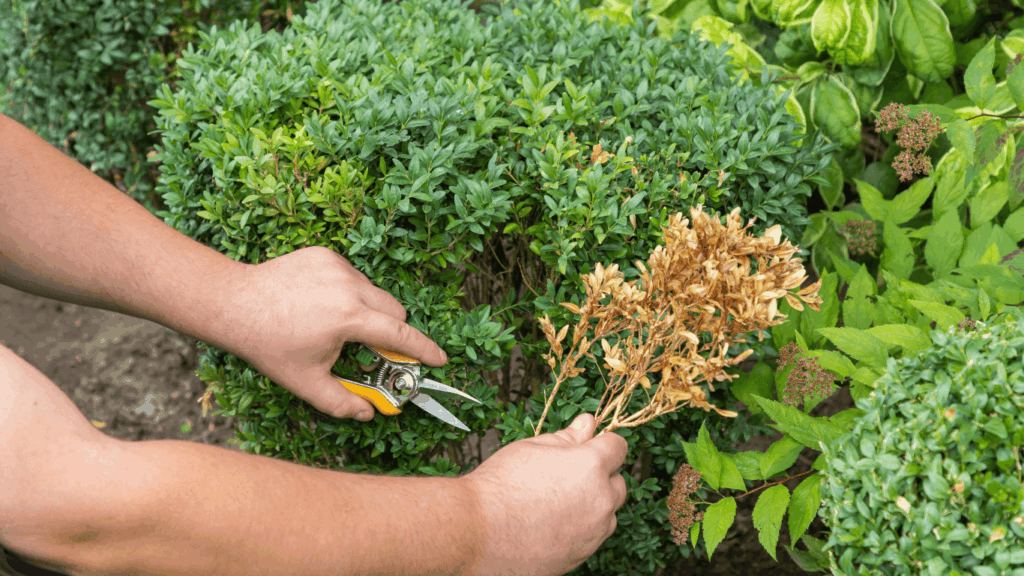
If you’ve noticed your beloved boxwood shrubs looking less than healthy, you might be dealing with a condition known as Boxwood Blight. This destructive disease has been affecting boxwoods across the country, including right here in Kansas City and the surrounding Northland areas. But don’t worry! In this blog, we’ll explain what Boxwood Blight is, how to recognize its symptoms, and what you can do to diagnose and manage the disease in your garden or landscape.
Overview: What is Boxwood Blight?
Boxwood Blight is a fungal disease caused by the pathogen Cylindrocladium buxicola. This disease primarily affects boxwood shrubs, which are commonly used in landscaping due to their dense foliage, versatility, and aesthetic appeal. Unfortunately, Boxwood Blight has become a growing concern in the Kansas City area and across the U.S. due to its rapid spread and potential to kill infected plants.
Boxwoods are highly susceptible to this disease, which can weaken the plant and cause significant damage if not properly addressed. What makes Boxwood Blight particularly concerning is that it spreads quickly from plant to plant and can be difficult to manage once established.
Symptoms of Boxwood Blight
Recognizing the symptoms of Boxwood Blight early is essential to preventing the disease from spreading throughout your garden or landscape. Common symptoms of Boxwood Blight include:
- Rapid Yellowing of Leaves: The first sign of Boxwood Blight is usually the yellowing of the leaves. This happens when the disease disrupts the plant’s ability to photosynthesize, causing the leaves to lose their green color.
- Brown or Black Spots on Leaves: As the disease progresses, you’ll notice dark brown or black spots forming on the leaves. These spots may appear water-soaked or have a slightly oily look, indicating the presence of the fungal spores.
- Defoliation: One of the most noticeable signs of Boxwood Blight is the shedding of leaves. Affected shrubs will lose their leaves prematurely, leaving behind bare branches, which gives the plant a sparse, unhealthy appearance.
- Stem Lesions: Boxwood Blight can also cause lesions on the stems of the plant. These lesions typically appear as dark, sunken areas that can eventually cause the stems to die off.
Fungal Growth: In more advanced cases, a white, fuzzy fungal growth may appear on the undersides of the leaves, particularly in the areas where the disease has spread most severely.
Diagnosis: How to Confirm Boxwood Blight
If you suspect that your boxwood shrubs are affected by Boxwood Blight, it’s essential to get a proper diagnosis to confirm the disease and rule out other potential issues, such as boxwood caterpillar damage or fungal leaf spot.
Here’s how to diagnose Boxwood Blight:
- Look for Symptoms: Check for the characteristic symptoms described above, including yellowing leaves, black spots, premature defoliation, and lesions on stems.
- Inspect the Plant for Fungus: If you see white fungal growth on the undersides of the leaves or on the stems, it’s a strong indication of Boxwood Blight.
- Professional Diagnosis: If you’re unsure, it’s always a good idea to contact a professional landscaper or garden center in Kansas City to help identify the problem. You can also send a sample to a local university extension office or plant diagnostic lab for an accurate diagnosis.
Preventative Measures: If you haven’t had an issue yet but want to prevent Boxwood Blight, consider using disease-resistant boxwood varieties. Regularly inspect your boxwood shrubs and practice good garden hygiene, including removing any fallen leaves and debris, which can harbor fungal spores.
Managing Boxwood Blight
While there’s no cure for Boxwood Blight, early intervention can help prevent it from spreading. Here are some tips for managing the disease:
- Remove Affected Plants: If you identify a boxwood shrub that is infected with Boxwood Blight, remove the affected plant entirely, including its roots. Be sure to dispose of the plant in a way that will prevent the spores from spreading (i.e., do not compost the plant).
- Sanitize Your Tools: If you’ve been working with infected plants, clean your gardening tools thoroughly with a disinfectant (e.g., bleach solution or rubbing alcohol) before using them on healthy plants. This helps prevent the disease from spreading to unaffected areas.
- Pruning and Spacing: Prune any dead or infected branches from healthy plants to improve airflow and reduce the humidity that promotes fungal growth. Ensure that boxwoods are spaced properly to encourage airflow, which will help keep the foliage dry.
- Fungicide Treatments: There are fungicides available that can help prevent the spread of Boxwood Blight. Be sure to consult with a local landscaping professional in Kansas City or your garden center to select the best product and apply it correctly.
Replace Infected Plants with Disease-Resistant Varieties: If the damage is severe, consider replacing your boxwood shrubs with varieties that are more resistant to Boxwood Blight, such as ‘Green Velvet’ or ‘Wintergreen’.
Conclusion: Protect Your Boxwood Shrubs from Boxwood Blight
Boxwood Blight is a serious issue for gardeners in Kansas City and surrounding areas, but with the right knowledge and care, you can protect your boxwoods and keep your landscape looking beautiful. Regularly inspect your plants, remove infected ones promptly, and take steps to improve their health with proper care and treatment.
If you need help with diagnosis, treatment, or preventive care for your boxwood shrubs, Blue Sparrow Lawn & Landscape is here to assist. Contact us for professional advice, pruning services, and expert landscaping care to ensure your property remains healthy and vibrant all year long.
